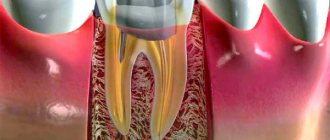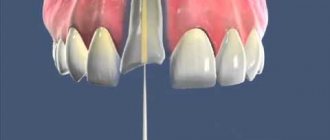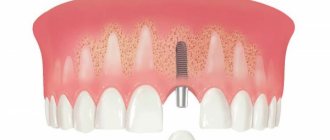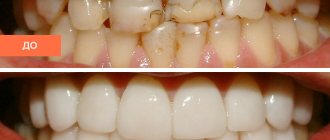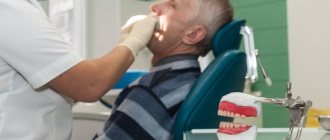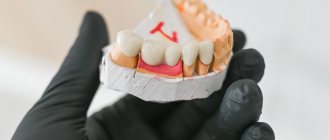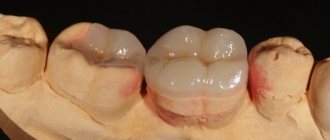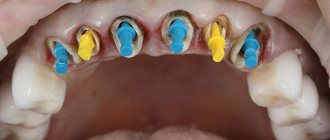Save our teeth!
Tooth decay, unfortunately, is an inevitable process that affects absolutely everyone. The sooner and more actively you start preventing it, the better.
Causes of tooth decay
- Caries.
Most often, dental problems occur due to an unbalanced diet, insufficient oral hygiene, and weakened immunity. As a consequence, the occurrence of this disease and fairly rapid destruction of the protective enamel layer and the entire tooth.
- Tooth deformation.
A lost filling can easily cause this painful process.
- Increased fragility of enamel.
It may be a congenital defect or a consequence of another disease - bruxism, when teeth experience increased stress due to friction against each other.
Filling teeth with inlays
Sealing on the pin is performed according to the following scheme:
- Initially, the specialist diagnoses the damaged tooth using various methods. The most informative is dental radiography.
- Radiography provides comprehensive data on: the depth and shape of the canal, the location of the roots. This allows you to select the pin of the desired shape and thickness.
- Dental restoration makes no sense without a sanitation procedure. An initial examination and identification of foci of infection and carious lesions will help avoid premature destruction of the restored tooth. The doctor treats all cariogenic areas and stops foci of inflammation.
- Procedures for preparing root canals for implant installation. The specialist removes the pulp (if required), expands the canals and performs mechanical cleaning. After cleaning with the instrument, it is necessary to rinse the canals with an antiseptic solution.
- Installation of the pin with the selected fastener. A custom or factory-made pin is placed in the root canal, and the remains are removed using a specialized instrument. The canal cavity is filled with dental cement.
- After installing the pin, the specialist begins restoration of the coronal part of the tooth.
- The doctor applies the photopolymer composite layer by layer and polymerizes it with an ultraviolet lamp. This is how the size of the tooth is gradually formed.
Contraindications for installation
Both implants and pins have a list of contraindications.
Contraindications for installing pins:
- damage and/or splitting of the tooth root;
- inflammatory periodontal diseases;
- cysts or granulomas in the area of the tooth root;
- tooth with pulp (the pulp must be removed before installation);
- if the thickness of the root canals is less than 2 mm (the canals are first expanded).
Contraindications to implantation:
- blood diseases;
- malignant tumors;
- severe forms of immunodeficiency;
- hypersensitivity to titanium;
- allergy to anesthetics used during implantation;
- severe neurological and mental illnesses;
- pregnancy and lactation.
There are also temporary contraindications for pins and implants. For example, these are inflammatory diseases or poor oral hygiene. For these purposes, treatment is initially carried out to eliminate all these disorders.
Filling on a pin in different types of teeth
The advantages of the method lie in the integrity of the structure. If there are no moving or multi-layered parts, the structure appears more durable.
When installing a filling on a pin, there is no deformation or impact on the adjacent teeth in the row. Their enamel is not destroyed, the patient does not experience discomfort after the procedure.
The main disadvantages of the method include the formation of secondary caries. If the specialist used low-quality materials or paid little attention to the examination, then caries will form under the surface of the filling. The tooth is pigmented black, but the filling does not change.
A poor-quality filling in a tooth is clearly visible
Pin or implant: advantages and disadvantages
It is incorrect to talk about the advantages of one product over another, since pins and implants have different purposes. Therefore, we will talk about the pros and cons of pins and implants separately.
Pros of implants:
- complete tooth restoration;
- long service life (up to lifelong);
- artificial teeth look good (practically no different from natural teeth);
- there are no dietary restrictions (implants can withstand the load when consuming all types of food);
- low probability of rejection (less than 1% of cases).
Cons of implants:
- the need for surgical intervention;
- standard risks associated with surgery (for example, infection);
- long period of treatment (up to 2-5 months);
- high cost of dental implantation.
The main advantage of the pin is that it allows you to preserve the existing natural tooth for a long time. But there are other advantages of these products.
Advantages of pins:
- the product is easily placed at the root;
- relatively low cost of the pin;
- high aesthetic indicators;
- the ability to attach a fixed or removable prosthesis.
Disadvantages of pins:
- relatively short service life (most often it is 2-3 years - the time for which it is possible to save a decaying tooth);
- instability to significant loads on the chewing teeth (if the load is uneven, the root walls can be damaged);
- wedging effect (pins expand the boundaries of the tooth, which can damage surrounding tissues)2;
- there is a danger of developing allergic reactions;
- the likelihood of developing secondary caries increases;
- Metal pins can only be removed together with the tooth.
Installation of a tooth crown. Types of crowns and fixation methods
Dental crowns help restore the chewing function of the tooth and ensure full load. The method has a large number of indications for use:
- A strong tooth root, but a significant absence of the crown part. A pin is installed in the root, and an individual crown is fixed onto it.
- Strong enamel pigmentation that cannot be bleached. The indication may apply to several teeth at the same time.
- The presence of progressive non-carious dentin diseases.
- Abrasion of tooth enamel; destruction of enamel under the influence of exogenous or endogenous factors.
Differences between an implant and a post
First, let's understand the concepts:
- An implant is a rod (usually titanium) that is inserted (screwed) into the jawbone. Essentially, an implant (or implant) is an artificial tooth root. An abutment is then installed on it, and then a crown.
3d model of a dental implant
- A pin is a thin (compared to an implant) rod that is installed into the root of the tooth. These products are used to preserve natural roots and strengthen the crown part of the tooth (provided that it is preserved by at least 50%)1.
3d model of a dental pin
If implants are used when a tooth with a root is no longer there, then pins are used to save teeth that have not yet been lost (but need strengthening). The main condition for installing a pin is intact root canals.
The main differences between an implant and a pin are given in Table 1.
Table 1. Characteristics of pins and implants
| Parameter | Implant | Pin |
| Installation method | Implanted into the bone, imitating tooth roots | Placed in the root of the tooth |
| Purpose of the product | Tooth root replacement | Strengthening and preserving natural teeth |
| How long does it last | Several decades | The pin slows down tooth decay. Service life depends on the condition of the tooth |
| Additional treatment | Sometimes bone grafting is needed (if there is not enough bone tissue in the jaw) | It is necessary to remove the dental nerve and fill the canals |
| Treatment period | 2-5 months | Up to 1 month |
| Price | High | 3-7 times cheaper than implants |
Preparatory actions
Before installing a crown, the doctor must diagnose and sanitize the oral cavity. If there is cariogenic damage on the tooth for restoration, then the doctor carries out treatment.
Teeth crowns are simply placed on the base
The next preparatory stage is turning the tooth or installing a pin. If the coronal part is completely destroyed, but the root is strong, a stump tab is installed. The stump tab strengthens the canals and allows you to securely fasten the crown.
FAQ
What to choose - a pin or an implant?
This is decided by the doctor. There are indications for installing pins, and there are indications for implantation or prosthetics. If the tooth can still be saved by strengthening it, then it is often suggested to install a pin. If the doctor sees that the pin only saves the situation for a short time, then he can immediately offer the patient the option of implantation, so as not to waste any extra money or time.
Is it possible to install a pin in a dead tooth?
The pin is installed after depulpation - removal of the vascular bundle with nerves (pulp). If this is not done, the pin will constantly irritate the nerve endings, which results in pain. Therefore, the pin is installed only on a dead (i.e., pulpless) tooth.
What is more expensive - a pin or an implant?
An implant is 3-7 times more expensive. The price factor is one of the most important when deciding to install a dental post or implant. At the same time, the patient needs to understand that the pins are short-lived, and in a few years (at best) he will again have to face the problem of tooth restoration. Therefore, in the future, placing implants may be cheaper than other types of restoration and restoration of the dentition.
Which is more painful to install?
The procedure is performed under anesthesia, so the patient will not feel anything. Since installing implants is a more invasive method (since incisions are required in the jawbone), the postoperative period may be accompanied by pain. Painkillers are used for this.
ATTENTION!
This material is not a substitute for medical advice and should not be used for diagnosis or treatment.
Sources:
- Aurélio IL, Fraga S, Rippe MP, Valandro LF. Are posts necessary for the restoration of root filled teeth with limited tissue loss? A structured review of laboratory and clinical studies. Int Endod J. 2016 Sep;49(9):827-835. doi: 10.1111/iej.12538. Epub 2015 Sep 19. PMID: 26331486.
- Goracci C, Ferrari M. Current perspectives on post systems: a literature review. Aust Dent J 2011 Jun;56 Suppl 1:77-83. doi: 10.1111/j.1834-7819.2010.01298.x. PMID: 21564118.
Types of dental crowns
Modern aesthetic dentistry offers a large number of materials for prosthetics; each patient will be able to choose a material according to their capabilities.
What is better: a pin or a crown on a tooth: features and differences.
Today, technology has advanced far forward, and with their help it is possible to restore a damaged or destroyed tooth and even grow a new one, much stronger and more beautiful than the previous one. There are two main procedures: installing a post or a crown. This article provides a description of the methods, their comparison and recommendations for selection.
A dental pin is a rod designed to strengthen a damaged or dilapidated tooth. The device is installed in the root zone or directly into the dentin, and a hardening mass is built up on top. The main function of the pin is to strengthen the entire tooth so that it does not break under load on the filling or the extended part.
There are two types of pins:
- Metal (titanium, brass, palladium, steel, gold (with impurities).
- Non-metallic (fiberglass, ceramics, carbon fiber).
The shape of the device is conical, cylindrical, cylindrical, screw.
According to the method of fixation, the pins are divided into:
- Active - a solid rod has a special thread with which it is screwed into the dental tissue. This type of pin is used to restore a completely or almost completely destroyed tooth, since when used, a strong load is created that can cause the tooth to split.
- Passive - the rod is fixed in the root canal using a special reinforcing material. This type is used to strengthen the tooth after treatment.
Indications for installation: half-destroyed or completely missing natural dental crown, creation of support when installing removable and fixed dentures.
Contraindications: diseases of the blood and nervous system, inflammatory pathologies of the oral cavity, caries, cysts in the oral cavity, root length is less than the planned crown height, root walls are too thin (less than 2 mm).
A crown is a dental prosthesis designed to strengthen a tooth, restore its previous shape and give an aesthetic appearance.
Crowns are not installed on the front teeth, only on the chewing ones. For the front teeth, there are veneers - thin plates made exactly to the shape of the teeth and installed on their front part.
Devices are made of ceramics (porcelain), metal, cermets, and plastics.
Crowns can be placed on a post, a damaged tooth, or an entire tooth (to give your smile a beautiful appearance and make it snow-white).
- Restoring the shape of a tooth destroyed as a result of injury, caries and other reasons.
- Restoration of chewing functions.
- Strengthening dentin.
- Whitening and improving the appearance of teeth.
Contraindications to applying a crown are age under 18 years, inflammatory diseases of the oral cavity, caries, too thin walls of the visible part of the tooth, chronic diseases in the acute stage, abnormal bite.
Alveolitis
There is no need to rush to remove a decayed tooth. Dentists recommend restoration at the slightest opportunity. Even if you managed to save a small fragment or only the root. Otherwise, there is a threat of alveolitis - a disease of the processes on which the teeth are held. They are called alveoli.
When the wound left after tooth extraction is still open, the alveoli are practically not protected from external infections. In the infected socket of the extracted tooth, the blood thickens, the pain quickly intensifies, the temperature soars to 39 degrees, the wound festers, and the smell of the mouth deteriorates. You can avoid these troubles if you replace the removal of the problematic tooth with restoration using a crown or pin.
Advantages of treatment at the GDenta clinic
GDenta dentistry installs crowns on 1 tooth using high-quality materials and advanced equipment. We provide a guarantee for prosthetics services and related manipulations. Do not delay treatment if installing a prosthesis is currently beyond your means: our clinic provides interest-free installments.
We try to make prosthetics a gentle procedure, therefore we ensure the physical and psychological comfort of patients. Our doctors develop an individual treatment plan for each patient. Sign up for prosthetics by calling: +7 (495) 312 2504 and +7 (925) 891 8353. We are waiting for you at the address: Moscow, st. Podolsk cadets, 3.
Rehabilitation period and rules of care
As a rule, getting used to a crown on a pin occurs very quickly, because due to its small size and anatomical shape, it does not seem like a foreign body. At first, the tooth may ache a little, the gums around it may turn a little red due to installation errors - to relieve symptoms, rinse with a solution of soda or chamomile infusion.
While wearing a temporary crown and in the first week after installing a permanent one, you should chew food on this part of the dentition more carefully so that the denture does not fall off. When wearing any type of prosthesis, it is not recommended to eat hard foods, taffy, or chew nut shells or seeds. To keep the crowns from darkening and the gums to be healthy, you should brush your teeth with a brush and toothpaste 2 times a day, incl. special for prostheses. And also avoid brightly colored foods and drinks.
Expert opinion
Roman Borisovich Alekperov
orthopedic dentist
Experience: 24 years
Restoring a tooth using a core inlay is a more effective method of microprosthetics than using pins. Inlays are gradually replacing pins, the only exception being cases of pinning using innovative materials, for example, fiberglass. Unlike metal, it is highly biocompatible, while being strong and durable. However, if the root is curved or too thin, even a fiberglass pin will be useless - only a stump inlay can be used.
Installation of pins for dental prosthetics
Installed pin
Preparations for the installation of pin structures should not be made on the day of the operation, but during a preliminary consultation. After the dentist has determined the feasibility and possibility of pin prosthetics, he must analyze in detail the condition of the tooth and study the thickness of its tissues. Taking into account all factors, the doctor selects the optimal materials and types of fastening.
If inflammatory processes and any other pathologies that may complicate the operation have been identified, they are treated.
After this, additional inspection is required. When the doctor is convinced that there are no contraindications, immediate preparation for prosthetics will begin.
The day before the installation of the pin, it is recommended to undergo a teeth cleaning procedure to remove stones and plaque. This will help minimize the number of bacteria that can get onto the wound surface after manipulation. You should not eat for six hours before the pin is inserted.
Procedure
First of all, an injection of anesthesia is injected into the gum to numb the area of work. After the anesthesia has taken effect and the doctor has checked the surface for susceptibility, installation work begins. The dentist prepares the root canal, removes nerves, cleans and, if necessary, widens the canal. The work area is treated with an antiseptic solution.
If a passive pin is used, the channel is pre-filled with a cementitious mixture, and the rod is immersed in it. The active pin is screwed into the channel, and the voids are filled with a polymer composition. For better fixation, the solution is dried with a halogen lamp.
Photo: how to place a pin in a tooth
When the rod is screwed in and securely fixed, a pre-made artificial tooth prosthesis is placed on it. Temporary cement is used for fixation; this is done in order to test the material for rejection. If the surrounding tissues of the oral cavity reacted normally to the foreign element, after a week the denture is placed on a permanent basis. If necessary, the doctor adjusts it using grinding. After installing the pin, the patient should not have the slightest discomfort,
the further outcome of treatment depends on strict adherence to the dentist’s recommendations.
Rehabilitation
The first time after installing the pin, you must strictly adhere to a number of restrictions and recommendations. Only the doctor who performed the treatment can say how long the rehabilitation period will last. For the entire period of rehabilitation you should:
- Eliminate from the diet hard and viscous foods that require active chewing movements. Food should be soft or even ground.
- On the first day you should not brush your teeth, only rinsing is acceptable. In the future, you will need to give preference to brushes with soft or medium bristles.
- Avoid foods and items that can damage the integrity of your teeth: nuts, seeds, toothpicks.
- Do not miss visits to the dentist and strictly follow individual recommendations.
Consequences, pain and complications after prosthetics
After the preparatory stage, installation of a rod or fixation of a crown, some patients feel discomfort - mainly pain. It is due to the fact that during the process of cleaning the canals, installing an orthopedic structure, and using a retraction thread, the surrounding healthy tissues were slightly injured. Normally, pain subsides within 3-5 days, less often – within 3-4 weeks (if pulpitis in a chewing tooth was treated).
If the pain only intensifies, becomes unbearable, the gums become very red, and an unpleasant taste or smell appears in the mouth, then it is likely that complications have begun. They are associated with poor-quality preparation of canals, manufacturing and installation of structures, and non-compliance with sanitary rules. Therefore, you must definitely contact the dentist.
How to install a crown
How to place a crown on a post? First, a translucent composite filling compound is applied to the rod and illuminated with a “blue” lamp. The doctor then takes impressions using impression material or an intraoral 3D scanner. Based on casts or virtual data, a model of the future prosthesis is formed, developed and manufactured by casting, pressing or milling on a robotic machine (CAD/CAM system). After the laboratory stage, the finished crown is handed over to the doctor, and it is placed on a pin (fixed with a cement composition).
While the permanent prosthesis is being manufactured, the patient is fitted with a temporary crown made of plastic or composite material. They have good aesthetics, are made in 1 day and are designed to protect against aggressive environmental factors.
Advantages of stump inlays:
- two parts of the tab (under and above the gum) are one material, one-piece design, so its separation and damage is impossible, even if the tab is collapsible, its main part is solid:
- the inlay accurately follows the contours of the internal cavity of the tooth:
- minimal load on the walls of the tooth – protection from rapid destruction;
- uniform load on the tooth and tissues around it;
- it is possible to use an inlay even if the tooth root is bent;
- it is possible to use various materials (cobalt-chrome, gold-based alloy, zirconium dioxide), including for patients with an allergy to metals;
- it is possible to achieve unsurpassed aesthetic results when using metal-free inlays, for example, from zirconium dioxide;
- long service life - more than 10 years.
